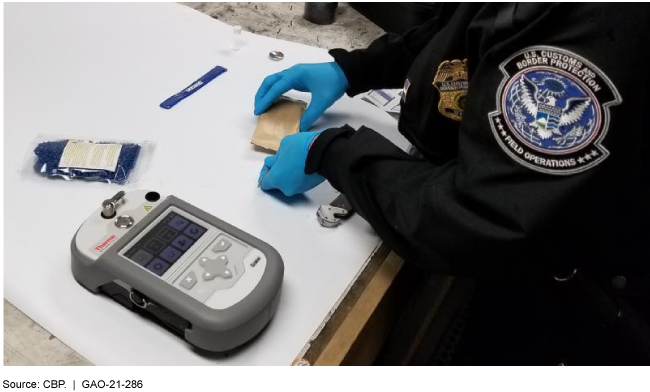Border Security: CBP Has Taken Actions to Help Ensure Timely and Accurate Field Testing of Suspected Illicit Drugs
Fast Facts
U.S. Customs and Border Protection officers and agents encounter substances they suspect are illicit drugs at ports and along the borders. "Presumptive field tests" can help them identify these substances using various tools, such as color-changing test kits and handheld electronic testing devices.
A positive field test can help establish probable cause, but field results must generally be confirmed in a lab to be used in a criminal case.
CBP has taken steps to improve its field tests and lab confirmations, including deploying new test equipment, building new labs, using mobile labs, and providing training.
U.S. Customs and Border Protection officer using a presumptive field testing device

Highlights
What GAO Found
U.S. Customs and Border Protection (CBP) has policies and procedures for its officers and agents to test substances that they suspect are illicit drugs—referred to as a presumptive field test. Field officials that GAO spoke with said these policies and procedures provide sufficient guidance for conducting presumptive field testing. The policies and procedures address various topics, such as approved and recommended types of test equipment, use of the equipment, training, and requirements for documenting illicit drug seizures. They also address laboratory confirmation of field test results (confirmatory testing), which U.S. Attorney's Offices require for federal prosecution.
GAO found that CBP's Office of Field Operations and U.S. Border Patrol conducted at least 90,000 presumptive field tests associated with an arrest from fiscal year 2015 through 2020. The average time for CBP to complete confirmatory testing across its labs decreased from 100 days in calendar year 2015 to 53 days in calendar year 2020, as of September 2020. This occurred while the total number of requests for confirmatory testing increased from about 4,600 in calendar year 2015 to about 5,600 in calendar year 2020, as of September 2020. With regard to accuracy, CBP officials have taken initial steps to upgrade the software system used to document confirmatory test results. This should provide CBP with information on the extent to which presumptive field test results align with confirmatory test results.
Average Time to Complete Confirmatory Testing and Number of Requests for Confirmatory Testing Processed Across all U.S. Customs and Border Protection (CBP) Laboratories, Calendar Year 2015 through September 24, 2020

CBP has taken a number of actions to help ensure timely and accurate field drug testing, including:
- Identifying, testing, and deploying test equipment. For example, CBP tested multiple types of chemical screening devices to determine their performance and capabilities to detect fentanyl at low purity levels.
- Enhancing presumptive and confirmatory field testing capabilities by building permanent onsite labs and deploying mobile labs in certain field locations.
- Providing round-the-clock access to chemists who help interpret presumptive field test results.
Why GAO Did This Study
Within the Department of Homeland Security, CBP reported seizing approximately 830,000 pounds of drugs in fiscal year 2020. When CBP officers and agents encounter suspected illicit drugs, they conduct a presumptive field test. A positive test result is one factor CBP uses to establish probable cause for an arrest or seizure. GAO was asked to review issues related to CBP's field drug testing.
This report examines (1) CBP's policies and procedures for testing suspected illicit drugs in the field; (2) available data on CBP's field drug testing; and (3) CBP's efforts to help ensure timely and accurate test results.
GAO analyzed CBP data on presumptive field testing and laboratory confirmation of results from fiscal year 2015 through 2020; reviewed related policies and procedures; and interviewed CBP officials in five states at land, air, and sea ports of entry, Border Patrol stations and checkpoints, and CBP labs. GAO selected these locations to include varying levels of drug seizures, among other factors.
For more information, contact Rebecca Gambler at (202) 512-8777 or gamblerr@gao.gov.
